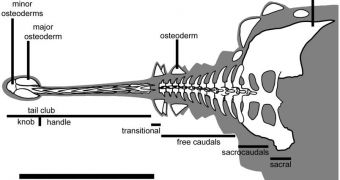While dinosaurs as Tyrannosaurus Rex are often considered to have been among the most brutal giant lizards to have ever walked the land, investigations have revealed over the years that some herbivores were not that bad at surviving, or at tearing their opponents to pieces themselves. University of Alberta Department of Biological Sciences expert Victoria Megan Arbour recently published a new scientific study, which looked for the first time at what kind of strength the Tails of dinosaurs had, and if they could indeed inflict massive damage on their predators. The paper appears in the August 25th issue of the open-access journal PLoS One.
Using fossilized remains of several ankylosaurid tails, the expert and her colleagues subjected them to computed tomographic (CT) scans, in order to get a better view of their internal structure. The team carefully analyzed how the bones were interlocked, how the muscles criss-crossed over them, and then tried to estimate the amount of torque and angular acceleration that the animals might have obtained when swinging their club-tails for their lives. One of the most important finds was that the tail could be moved to a 100-degree angle sideways, though vertical mobility was a bit more limited.
“The gross and internal morphology of ankylosaurid tail clubs suggests that these structures evolved for delivering forceful impacts. Muscle scars on the pelvis suggest that a large M. longissimus caudae was present, which may have resulted in a powerful swing. Ankylosaurid caudal vertebrae are lightly constructed, resulting in a slender tail. However, ankylosaurids with average to large knobs were able to generate large impact forces,” Arbour writes in the paper.
She adds, “This study modeled tail club impact forces with the assumption that the lateral movement of the tail begins only at the anterior free caudal vertebra, and does not incorporate movement of the body using the hips and hind limbs. This simplified model almost certainly underestimates the impact force of a tail club, and if ankylosaurids engaged in this behavior then the hips and hind limbs would probably have played an important role in tail swinging.”

 14 DAY TRIAL //
14 DAY TRIAL //